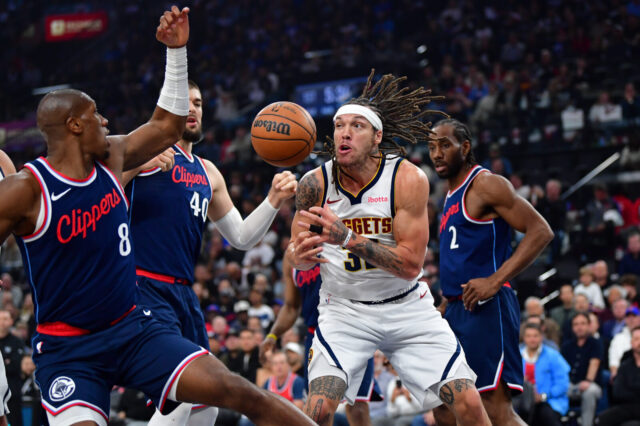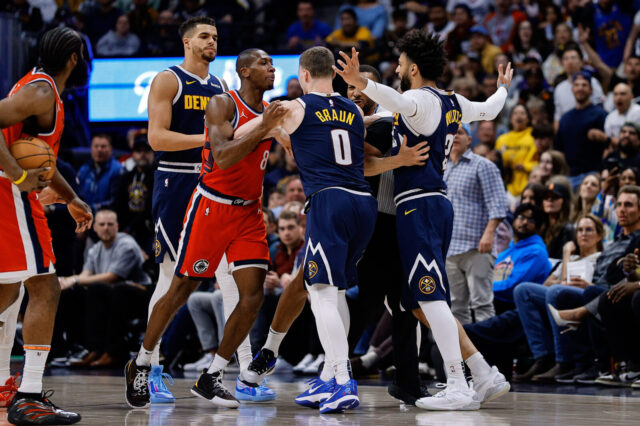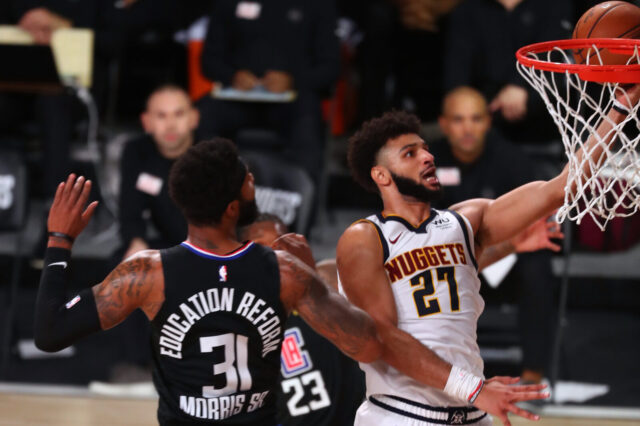Some see the natural progression for this Denver Nuggets team is to become a championship contender immediately during the 2019-20 season. As currently constructed, call me skeptical for a variety of reasons.
That doesn’t mean that the Nuggets can’t be really good of course, as Denver’s roster is built to rack up wins in the regular season and will likely finish with a top 4 seed, captained by superstar Nikola Jokic, up-and-comers Jamal Murray and Gary Harris, and defensive-minded veteran Paul Millsap. And yet, it’s okay to have a healthy concern about Denver’s top end ceiling in this particular year. The same core and supporting pieces are back that lost to an injured Portland Trail Blazers roster in the second round last season, and while growth is certainly the expectation, it definitely isn’t a guarantee with regression also looming.
The mantra for Nuggets basketball the last several years has been consistent: “we don’t skip steps.” Making the playoffs was a step. Winning a playoff series was a second step. It’s very possible that the Nuggets are still on step two of their playoff progression rather than jumping to “make the Conference Finals” or “Win the Western Conference” which is where the expectations for many Nuggets fans currently fall. Denver proved they had a championship foundation last season, but cultivating that foundation can take teams many years. The Oklahoma City Thunder featuring Kevin Durant, Russell Westbrook, James Harden, and Serge Ibaka had a quick ascension to the top of the NBA over a three-year period, but the Nuggets don’t have that much top end talent on their roster (three potential MVPs, potential DPOY) unless something unexpected happens with Murray and Michael Porter Jr. in the next year. It’s far more likely that Denver’s climb is steady until they reach a ceiling or break through those limits with other unexpected leaps.
With that in mind, understanding the make-up of an NBA champion is important for a number of reasons. The Nuggets have an untraditional group. Can untraditional groups work, and what is needed to cultivate that championship ceiling? What level of offense and defense do champions have? How great is the superstar and his supporting cast?
Let’s profile the champions of the 21st century.
Team Winning Metrics
This section will cover the basic win metrics that measure the regular season strength of each of the last 19 NBA champions, ranging from simple win percentage to Net Rating to Simple Rating System. Net Rating measures the difference between points scored per 100 possessions and points allowed per 100 possessions. Simple Rating System (SRS) measures point differential against the champion’s strength of schedule during the season since the NBA schedule features unbalanced conferences.
When measuring each of those metrics during the last 19 years, it becomes clear that Denver is close but not quite there yet. The average win total for an NBA champion has been roughly 59.7 wins, but removing the Golden State Warriors (an abnormally strong dynasty) from that group lowers the average win total. Average champion Net Rating was +7.11 per 100 possessions, but interestingly enough, the only team in 2018-19 to cross that threshold was the Milwaukee Bucks at +8.6, while the Toronto Raptors won a ring with a +5.8 margin. Finally, the average SRS of the included teams was +6.62, with Milwaukee again being the only team to cross that threshold in 2018-19.
For the Nuggets, the 54 wins they accumulated may be enough for a championship in some years, but in order to feel supremely confident about Denver’s championship equity, they should probably have the talent to go for 60 wins or greater. With a +4.0 Net Rating and a +4.19 SRS, the Nuggets clearly weren’t at the level of most historical contenders last season. That could all change with the right development from certain pieces like Murray, Harris, and Porter, but Nuggets fans should remain cautious about this unit’s ceiling unless some immediate improvement occurs.
Offensive Four Factors and Play Style
Over the last 10 years, an interesting trend arose in the NBA champions after primarily focusing on the defensive side of the ball: teams became offensive juggernauts instead.
This content is no longer available.
One of the primary “Four Factors” offensively, effective field goal percentage is the primary factor with the most correlation to offensive ratings. As can be seen over the last nine years, the teams with the most talented shot makers combined with the best shot selection have generated great offenses. The Warriors topped this metric for many years, even if they struggled with turnovers, don’t grab a ton of offensive rebounds, and don’t get to the free throw line as often as other teams. Each of those components is one of the four factors offensively, but the most important factor is taking and making as valuable of shots as possible.
This is my biggest concern with Denver’s current construct offensively. Right now, the Nuggets have maintained an average eFG%. During a healthy season, they probably reach about 10th. That just isn’t going to cut it when clutch time in the postseason rolls around. When opposing teams focus more heavily on rebounds and playoff free throws are more difficult to come by, simply having shot makers is the best way to advance. The best way to make those shots as easy as possible: properly space the floor and acquire floor spacers that make defenses pay for leaving them open.
Jokic is an extremely unique player, and an argument could be made that the best possible fit next to him is acquiring a forward who circles the paint and attacks the glass following Denver’s primary attack; however, I am of the mind that Denver maximizing as much space around Jokic as possible will begin a return of cuts, higher spot up frequency, and playing faster in transition, all ways that the above championship franchises maximized their individual efficiency.
Defensive Four Factors and Play Style
The focus on defensive efficiency has been far less prevalent than identifying the proper spacing and offensive efficiency the last several years.
This content is no longer available.
The Dallas Mavericks are generally seen as the exception rather than the rule for developing a championship contender, and given that, the other eight teams have generated top 6 offenses, while only five times has a team been a top 6 defense. At this point, history says that it’s more important to build a contender with an elite offense. Of course, teams that are top 5 in both generally fare well too.
It should give confidence to Nuggets fans that two of the championship runs by the Warriors and Cleveland Cavaliers featured a defense that wasn’t elite but merely good. With Denver’s personnel, it’s more likely that Denver follows the suit of these franchises, as there’s no Tim Duncan or Kawhi Leonard on the roster to be a defensive foundation, but adding enough competent pieces over time has helped Denver compete on that end. Look for more of the same.
For reference, every champion over the last 18 years has finished in the top 10 in opponent eFG%, meaning the defense is preventing the same kind of shots the championship caliber offenses are trying to take. Denver finished 15th in the same metric this past year but 10th in Defensive Rating particularly because of their strong rebounding and limited time sending the opposition to the free throw line; however, the talent of stopping stars at all positions will help Denver become a more comprehensive unit, something they may not be able to accomplish with the personnel they have.
Team Construction
In eight of the last nine seasons, LeBron James and his teams have represented one half of the NBA Finals bracket. He may have only won three of those championships, but his treks to the Finals and both successes and failures can teach the Nuggets a lot about what teams utilized to stop him when they got there.
The 2011 Mavericks featured a variety of smart players that operated at wing size, including Jason Kidd and Shawn Marion. They also had an elite rim protector in Tyson Chandler to go with their offensive minded scorers in Nowitzki and Jason Terry. The Mavericks weren’t an elite unit in any category, but Nowitzki and Terry presented mismatch issues for Miami while Kidd matched up with Wade and Marion matched up with LeBron as well as he could.
The 2014 Spurs were perhaps the most balanced team of all-time, with no starter averaging more than 29.4 minutes per game. They aren’t a great representation for the Nuggets because both teams are at an entirely different stage of their tenures.
The 2015 Warriors on the other hand are a great representation for how the Nuggets must operate as a championship contender. Golden State found a way to do things differently while built around a unique superstar in Stephen Curry, who had skills that changed the NBA forever. The Nuggets are hoping for Jokic to have a similar impact as a playmaking big. No center has ever done the things that Jokic has done, and this uniqueness could be what carries them to a Finals appearance. Curry had help though, as the Warriors identified several pieces that fit around him perfectly, including splash brother Klay Thompson, defensive anchor and offensive playmaker Draymond Green, and Swiss army knife Andre Iguodala.
When it’s all said and done, the Nuggets, if they are to lay it all out there and proclaim themselves legitimate championship contenders, must find pieces that fit around Nikola Jokic at an elite level. Not just pretty good. Elite. They bet that Jamal Murray is one of those pieces and are hoping that Gary Harris is another. They drafted Michael Porter Jr. and added Jerami Grant in the hopes that both of those forwards fit into that picture in some way. Those five players will likely determine whether a championship in Denver is a reality or not for the current roster.
Superstar Archetype
Finally, the lead Superstar is the most important piece of the puzzle. Very few players in the 21st century can say they were the first option on an NBA champion. LeBron James, Stephen Curry, Kawhi Leonard, Dirk Nowitzki, Kobe Bryant, Kevin Garnett, Tim Duncan, Dwyane Wade, and Shaquille O’Neal are the names that lead that discussion. When it’s all said and done, it wouldn’t surprise me if all of those players are top 30 players in the history of this game, with at least five of them having a claim for top 10.
Is Nikola Jokic like that? Is Jamal Murray? Can either of them be first option scorers at that high level?
This content is no longer available.
Above is a graph that connects the Usage Rate and True Shooting Percentage of the top options on championship teams and their numbers during the regular season. It isn’t a perfect way to showcase playoff numbers, but it sets the foundation for what those championship teams needed from their lead star on a consistent basis. In blue, the most recent champions almost all group in he top right corner of this graph except 2013-14 Tony Parker, who led the balanced Spurs in Usage that season and wasn’t relied upon as heavily as most. In red are the first options on championship teams in the 2000’s decade, and the discrepancy between the 2000’s and 2010’s is important. Efficiency has reached an entirely new level in a short time, and the expectations placed on stars now is clearly higher.
This means that the threshold requirements for a first option superstar in today’s NBA are about a 28% Usage Rate and a 60% True Shooting Percentage. The averages for 2011-19 are slightly higher at 29.8% and 61.6% respectively, but the threshold to reach that level isn’t out of reach for Jokic, who posted 27.4% Usage and 58.9% True Shooting marks in 2018-19. He also maintained his level in the playoffs over heavier minutes, generating a +8.3 Offensive Box Plus-Minus during the 2019 playoffs which ranks 9th among all playoff performers in the 21st century with a minimum of 500 minutes played. Jokic isn’t a traditional first option because of his status as a playmaking center, but the closer he gets to a 30% Usage mark and 62% True Shooting mark, the better the Nuggets will be.
Murray isn’t close to the level of those top championship level scorers right now, but he has the talent to get there. There’s an outside chance that he will reach those thresholds, but it’s important for Nuggets fans to see the climb Murray will have to make in order to temper their immediate expectations for next season.
So, are the Nuggets close to becoming a championship contender? Absolutely. They have a variety of interesting pieces and a foundational superstar who changes the game in much of the same way that other top champions did before him. Understanding that the Nuggets need to reach elite levels of offensive efficiency while maintaining borderline elite defensive efficiency is important though, because the personnel that may be limiting Denver on offense is quite possibly what is helping them on defense. By committing to a player like Michael Porter Jr. in the hope of seeing a new level of offense, the Nuggets may lose the defensive impact of Torrey Craig. By starting Paul Millsap over Jerami Grant, the Nuggets will maintain their solid defense but possibly lose the top threshold of offensive spacing and efficiency they must reach in order to hit offensive nirvana.
There are too many questions in my mind, too many rotational discussions on which players are the best fits and offer the best ceiling, to predict a championship for Denver this year. In addition, Denver’s young pieces still have steps to go in their development, and the final product of Nuggets basketball has yet to be seen.
That doesn’t mean Nuggets fans shouldn’t root for a championship this year though, and it still might happen, even if it involves some difficult decisions along the way.


